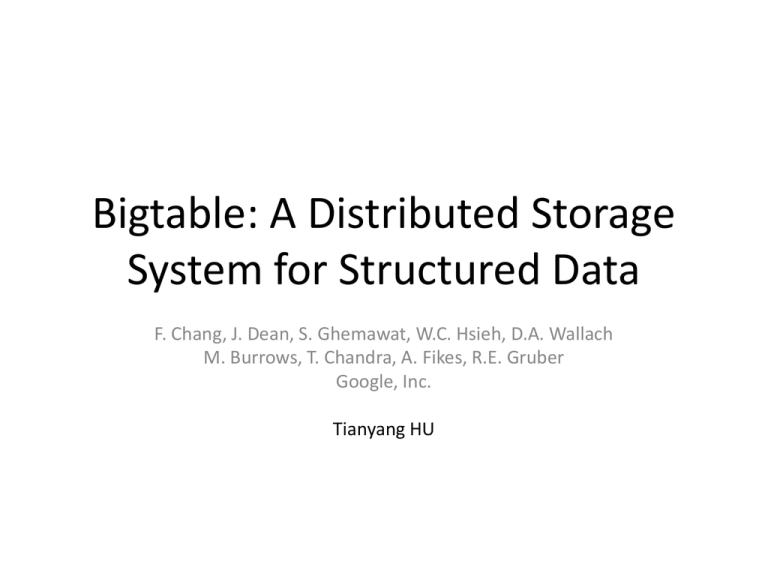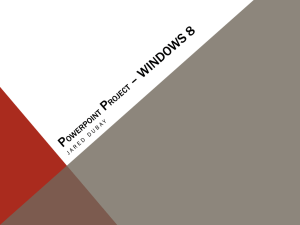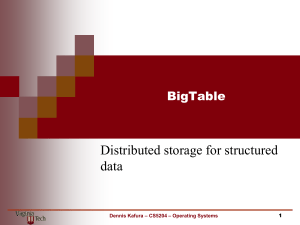Slides
advertisement

Bigtable: A Distributed Storage System for Structured Data F. Chang, J. Dean, S. Ghemawat, W.C. Hsieh, D.A. Wallach M. Burrows, T. Chandra, A. Fikes, R.E. Gruber Google, Inc. Tianyang HU Outline • • • • • • • Introduction Data Model Building Blocks Implementation Refinements Performance Evaluation Future Work 2 Motivation • Scalability – worldwide applications & users – huge amount of communication & data 3 Bigtable • Distributed storage system – petabytes of data, thousands of machines – simple data model with dynamic control – applicability, scalability, performance, availability • Used by more than 60 applications of Google 4 Outline • • • • • • • Introduction Data Model Building Blocks Implementation Refinements Performance Evaluation Future Work 5 Data Model – Overview • Sparse, distributed, persistent multidimensional sorted map. 6 Data Model – Example • “Webtable” stores copy of web pages & their related information. – row key: URL (reverse hostname) – column key: attribute name – timestamp: time that the page is fetched 7 Data Model – Rows • Row key: string (usually 10-100KB, max 64KB) • Every R/W of data under a single row key is atomic 8 Data Model – Rows • Sorted by row key in lexicographic order • Tablet: a certain range of rows – the unit of distribution & load balancing – good locality for data access 9 Data Model – Columns • Column families: group of column keys (same type) – the unit of access control • Column key: family:qualifier 10 Data Model – Timestamps • Timestamp: index multiple versions of the same data – not necessarily the “real time” – data clean up, garbage collection 11 Outline • • • • • • • Introduction Data Model Building Blocks Implementation Refinements Performance Evaluation Future Work 12 Building Blocks • SSTable file format – persistent, ordered, immutable key-value (string-string) pairs – used internally to store Bigtable data 13 Building Blocks • GFS – store log & data files – scalability, reliability, performance, fault tolerance • Chubby – a highly-available and persistent distributed lock service 14 Outline • • • • • • • Introduction Data Model Building Blocks Implementation Refinements Performance Evaluation Future Work 15 Bigtable Components • A library that is linked into every client • Many tablet servers – handle R/W to tablets with clients • One tablet master – assign tablets to tablet servers – detect addition & expiration of tablet servers – balance tablet-server load 16 Architecture 17 Tablet Location • Three-level hierarchy – root tablet (Only one, stores addresses of METADATA tablets) – METADATA tablets (stores addresses of user tablets) – user tablets 18 Tablet Location • Client caches (multiple) tablet locations – if the cache is stale, query again 19 Tablet Assignment • The tablet master uses Chubby to keeps track of – live tablet servers • each live tablet server acquires an exclusive lock on a corresponding file – tablet assignment status • compare tablets registered in METADATA tablet with tablets in tablet servers 20 Tablet Assignment • Case 1: some tablets are unassigned – master assigns them to tablet servers with sufficient room • Case 2: a tablet server stops its service – master detects it and assigns outstanding tablets to other servers. • Case 3: too many small tablets – master initiates merge • Case 4: a tablet grows too large – the corresponding tablet server initiates split and notifies master 21 Tablet Serving • A tablet is stored as a sequence of SSTables in GFS • Tablet mutations are logged in commit log – the “commit log” stores redo records – recent tablet versions are stored in memory (memtable) – older tablet versions are stored in GFS 22 Tablet Serving • Recover a tablet – 1. Tablet server fetches its metadata from METADATA tablet, which contains a list of SSTables that comprises a tablet and redo points. – 2. The server reads the indices of the SSTables into memory. – 3. The server applies all the mutations after the redo point. 23 Tablet Serving • Write operation on a tablet – – – – 1. The tablet server checks the validity of the operation. 2. The operation is logged in the commit log. 3. Commit the operation. 4. The content of tablet is inserted into memtable. 24 Tablet Serving • Read operation on a tablet – 1. The tablet server checks the validity of the operation. – 2. Execute the operation on a merged view of memtable & SSTables. 25 Compactions • Memtable grows as write operations execute • Two types of compactions – minor compaction – merging (major) compaction 26 Compactions • Minor compaction (when memtable size reaches a threshold) – 1. Freeze the memtable – 2. Create a new memtable – 3. Convert the memtable to an SSTable and write to GFS 27 Compactions • Merging compaction (periodically) – 1. Freeze the memtable – 2. Create a new memtable – 3. Merge a few SSTables & memtable into a new SSTable 28 Compactions • Major compaction – special case of merging compaction – merges all SSTables & memtable 29 Compactions • Why freeze & create memtable? – Incoming read and write operations can continue during compactions. • Advantages of compaction: – release the memory of the tablet server – reduce the amount of data that has to be read from the commit log during recovery if this tablet server dies 30 Outline • • • • • • • Introduction Data Model Building Blocks Implementation Refinements Performance Evaluation Future Work 31 Refinements • Locality groups – – – – group multiple column families together different locality groups are not typically accessed together for each tablet, store each locality group in a separate SSTable more efficient R/W 32 Refinements • Compression – similar data in same column, neighbouring rows, multiple versions – customized compression on SSTable block level (smallest component) – two-pass compression scheme • 1. Bentley and McIlroy’s scheme, compress long strings across a large window • 2. fast compression algorithm, look for repetitions in small window • experimental compression ratio: 10% (Gzip: 25-33%) 33 Refinements • Caching – two-level cache on tablet server – Scan cache (high-level): caches key-value pairs • Case: read the same data repeatedly – Block cache (low-level): caches SSTable blocks • Case: sequential read 34 Refinements • Commit-log implementation – – – – one commit log per tablet incurs a large # of disk seeks use single commit log for all tablets on a tablet server benefits significantly during normal operation complicates recovery • solution: sort the commit log entries first 35 Outline • • • • • • • Introduction Data Model Building Blocks Implementation Refinements Performance Evaluation Future Work 36 Performance Evaluation R/W rate per tablet server aggregate R/W rate 37 Outline • • • • • • • Introduction Data Model Building Blocks Implementation Refinements Performance Evaluation Future Work 38 Future Work • Resource sharing for different applications? • Hybrid with relational database? – complex query – security 39






